This homemade pita bread recipe is easy to make and requires a few ingredients you may already have on hand! Mix up the very simple dough, let it rise, and experience the magic of fresh, warm, perfectly puffy homemade pita bread. Baking and skillet instructions included!
Pita bread is freezer friendly. And you can even prepare the dough ahead. Be sure to read through for tips and my step-by-step tutorial.
Many ways to use pita bread!
Whether we’re talking falafel, shawarma, hummus or even deli meat, pita pockets are my go-to.
In fact, a basket of warm pita is almost always on the dinner table next to anything from soups and stews to saucy meatballs requiring something to sop up the delicious goodness.
I’ve turned pita into chips and churro chips! And when the kids need a good snack to hold them over until a late dinner, I serve up some pita with a little dish of za’atar and some extra virgin olive oil for dipping.
Is it worth it to make your own homemade pita bread?
YES! As someone who grew up on authentic fresh pita bread from Egyptian bakeries, I can tell you this: pita bread we buy at grocery stores here in the U.S. is simply not the same. Like store-bought sandwich bread, store-bought pita has typically been sitting on the shelf for a few days.
Don’t get me wrong, I have bought pita at the store many times. It must be warmed up and used pretty quickly.
But what I’m after here is: Fresh. Warm. Fragrant. Perfectly puffy pita bread. Making it takes me back to the streets of Egypt where I grew up.
Making pita bread at home is straightforward and takes just a few ingredients you probably already have on hand.
This recipe will make 8 pitas. And you can bake them in the oven or cook them stovetop in a hot skillet.
Ingredients
- Water
- Yeast
- Pinch sugar
- All-purpose flour (or a combination of all-purpose flour and whole wheat flour)
- Kosher salt (I use Diamond Crystal kosher salt)
- Extra virgin olive oil (I used Private Reserve Greek extra virgin olive oil)
Do I need a stand mixer to make pita bread?
No! In fact, I prefer to knead the dough by hand for my pita bread. You will not be doing too much kneading, and the result is almost better than using a stand mixer. Here’s all the equipment you need to make this pita bread recipe:
- Large mixing bowl like this one (affiliate link)
- Wooden spoon or anything to stir the dough
- A rolling pin (affiliate link) to flatten the pita like
How to Make Pita Bread: Step-by-Step
Step 1: Make sponge
Combine 1 cup lukewarm water in a large mixing bowl with yeast and sugar. Stir until dissolved. Add 1/2 cup flour and whisk together. Place the mixing bowl in a warm (not hot) place, uncovered. Wait about 15 minutes or until mixture is frothy and bubbling a bit
Tip: If you don’t see some bubbles, your yeast is dead. Start over with new yeast.
Step 2: Form the pita dough
Now add salt, olive oil, and the remaining flour (keep about 1/2 cup of the flour for dusting later). Stir until mixture forms a shaggy mass.
(What’s a shaggy mass? Basically, at this point, the dough has little to no gluten development and just looks like a sticky mess and you can easily pull bits off).
Dust with a little flour, then knead the mixture inside the bowl for about 1 minute incorporating any stray bits.
Step: 3 Knead the dough
Dust a clean working surface with just a little bit of flour. Knead lightly for 2 minutes or so until smooth. Cover and let the dough rest for 10 minutes, then knead again for a couple more minutes. The dough should be soft and a little bit moist, you can help it with a little dusting flour, but try not to add too much.
Step: 4 Let the pita dough rise
Clean the mixing bowl and give it a light coating of extra virgin olive oil. Put the dough back in the bowl and turn it a couple times just to coat it a bit with the olive oil.
Cover the mixing bowl tightly with plastic wrap, then cover it with a kitchen towel. Put the bowl in a warm (not hot) place. Leave it for 1 hour or until the dough rises to double its size.
Step 5: Divide the dough
Gently deflate the dough and place it on a clean work surface. Divide the dough into 7 to 8 equal pieces and shape them into balls. Cover with a towel and leave them for 10 minutes or so.
Step 6: Shape the pitas
Using a floured rolling pin, roll one of the pieces into a circle that’s 8-9 inches wide and about a quarter inch thick. It helps to lift and turn the dough frequently as you roll so that dough doesn’t stick to your counter too much. (If dough starts to stick, sprinkle a tiny bit of flour). If the dough starts to spring back, set it aside to rest for a few minutes, then continue rolling. Repeat with the other pieces of dough.
Tip: Once you get going, you can be cooking one pita while rolling another, if you like.
You have two options for baking the pita from here.
Step 7: Bake in the oven OR on stovetop
To bake pita in the oven: Heat the oven to 475 degrees F and place a heavy-duty baking pan or large cast iron skillet on the middle rack to heat. Working in batches, place the rolled-out pitas directly on the hot baking baking sheet (I was only able to fit 2 at a time).
Bake for 2 minutes on one side, and then, using a pair of tongs, carefully turn pita over to bake for 1 minute on the other side. The pita will puff nicely and should be ready. Remove from the oven and cover the baked pitas with a clean towel while you work on the rest of the pitas.
To cook pita in a skillet (stovetop): Heat a cast iron skillet over medium-high heat. (Test by adding a couple drops of water to the skillet, the skillet is ready when the beads of water sizzle immediately). Drizzle a tiny bit of extra virgin olive oil and wipe off any excess. Working with one pita at a time, lay a rolled-out pita on the skillet and bake for 30 seconds, until bubbles start to form.
Using a spatula, flip the pita over and cook for 1-2 minutes on the other side, until large toasted spots appear on the underside. Flip again and cook another 1-2 minutes to toast the other side. The pita is ready when it puffs up forming a pocket
Tip: Sometimes, with this stovetop method, the pita may not puff or may only form a small pocket. Try pressing the surface of the pita gently with a clean towel. Keep baked pita covered with a clean towel while you work on the rest.
Can the dough be prepared ahead?
Yes, you can prepare the dough ahead of time. Once it has risen, you can store it in the fridge until you need it!
If you don’t want to bake all 8 pitas on a given day, you can bake 1, 2 or however many you need at a time. Save the rest of the dough in the fridge for later (if stored properly, the dough will keep in the fridge for up to 1 week).
Can I make gluten free pita bread using this recipe?
Many of you have asked if this recipe can be made with gluten free flour. YES!
You can simply replace the flour here with the same amount of an all-purpose gluten free flour. Bob’s Red Mill all-purpose gluten free flour or Bob’s Red Mill 1 to 1 baking flour (<–affiliate link) will work in this recipe.
Why won’t my pita puff?
Note that pita will not stay puffy once it sits out of the oven for a bit. We want it to puff during the baking process so that it forms a pocket to hold all sorts of tasty items. But let’s just agree that even pitas that don’t puff and end up more like a flatbread without a pocket are still delicious.
That said, the main reason pita won’t puff has to do with baking temperature–the oven or the skillet aren’t hot enough. Make sure both are well-heated before cooking.
Storage and freezer instructions
Baked pita bread is best enjoyed fresh and hot-out-of the oven. But, you likely won’t finish 8 loaves of pita in one sitting unless you’re hosting a big dinner party. Good news is, pita bread will store well for a few days in an air-tight bag. Warm it up in your oven or toaster oven or even over open flame.
You can freeze pita bread for later use! Here’s what you do:
- Cool pita bread completely
- Store in zip-top bags. Make sure to push all the air out. Layer wax paper between the pitas, this makes it easy to pull just one pita at a time, if you like.
- Freeze for up to 3 months
- Warm frozen pitas up in a medium-heated oven. No need to thaw.
More bread and cake recipes here. For all recipes, visit us here.
JOIN MY FREE E-MAIL LIST HERE.
SHOP OUR ONLINE STORE FOR QUALITY OLIVE OILS, ALL-NATURAL SPICES AND MORE.
Print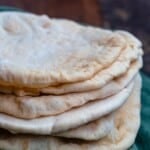
Homemade Pita Bread Recipe
- Total Time: 1 hour 48 minutes
- Yield: 8 whole pitas 1x
Description
My family’s authentic, fool-proof pita bread recipe is easy to make and requires a few ingredients you may already have on hand! Mix up the very simple dough, let it rise, and experience the magic of fresh, warm, perfectly puffy homemade pita bread. Baking and stovetop instructions included!
Ingredients
- 1 cup lukewarm water
- 2 tsp active dry yeast
- 1/2 tsp sugar
- 3 cups all-purpose flour, divided (or 1 1/2 cup all-purpose flour and 1 1/2 cup whole wheat flour)
- 1 to 2 tsp kosher salt (I used Diamond Crystal kosher salt)
- 2 tbsp extra virgin olive oil (I used Private Reserve Greek extra virgin olive oil), more for the bowl
Instructions
- Make sponge: In a large mixing bowl add the lukewarm water and stir in yeast and sugar until dissolved. Add 1/2 cup flour and whisk together. Place the mixing bowl in a warm place, uncovered to form a lose sponge. Give it 15 minutes or so, the mixture should bubble.
- Form the pita dough: Now add salt, olive oil and almost all the remaining flour (keep about 1/2 cup of the flour for dusting later). Stir until mixture forms a shaggy mass (at this point, the dough has little to no gluten development and just looks like a sticky mess and you can easily pull bits off). Dust with a little flour, then knead the mixture inside the bowl for about a minute to incorporate any stray bits.
- Knead the dough: Dust a clean working surface with just a little bit of flour. Knead lightly for a couple minutes or so until smooth. Cover and let the dough rest for 10 minutes, then knead again for a couple more minutes. The dough should be a little bit moist, you can help it with a little dusting of flour, but be careful not to add too much flour.
- Let the dough rise. Clean the mixing bowl and coat it lightly with extra virgin olive oil and put the dough back in the bowl. Turn the dough a couple times in the bowl to coat with the olive oil. Cover the mixing bowl tightly with plastic wrap then lay a kitchen towel over. Put the bowl in a warm place. Leave it alone for 1 hour or until the dough rises to double its size.
- Divide the dough. Deflate the dough and place it on a clean work surface. Divide the dough into 7 to 8 equal pieces and shape them into balls. Cover with a towel and leave them for 10 minutes or so to rest.
- Shape the pitas. Using a floured rolling pin, roll one of the pieces into a circle that’s 8-9 inches wide and about a quarter inch thick. It helps to lift and turn the dough frequently as you roll so that dough doesn’t stick to your counter too much. (If dough starts to stick, sprinkle a tiny bit of flour). If the dough starts to spring back, set it aside to rest for a few minutes, then continue rolling. Repeat with the other pieces of dough. (Once you get going, you can be cooking one pita while rolling another, if you like). You have two options for baking the pita from here.
- To bake pita in the oven: Heat the oven to 475 degrees F and place a heavy-duty baking pan or large cast iron skillet on the middle rack to heat. Working in batches, place the rolled-out pitas directly on the hot baking baking sheet (I was only able to fit 2 at a time). Bake for 2 minutes on one side, and then, using a pair of tongs, carefully turn pita over to bake for 1 minute on the other side. The pita will puff nicely and should be ready. Remove from the oven and cover the baked pitas with a clean towel while you work on the rest of the pitas.
- To cook pita on stovetop: Heat a cast iron skillet over medium-high heat. (Test by adding a couple drops of water to the skillet, the skillet is ready when the beads of water sizzle immediately). Drizzle a tiny bit of extra virgin olive oil and wipe off any excess. Working with one pita at a time, lay a rolled-out pita on the skillet and bake for 30 seconds, until bubbles start to form. Using a spatula, flip the pita over and cook for 1-2 minutes on the other side, until large toasted spots appear on the underside. Flip again and cook another 1-2 minutes to toast the other side. The pita is ready when it puffs up forming a pocket (sometimes, with this method, the pita may not puff or may only form a small pocket. Try pressing the surface of the pita gently with a clean towel). Keep baked pita covered with a clean towel while you work on the rest.
Notes
- Make ahead note: You can prepare the dough ahead of time. Once it has risen, you can store it in the fridge until you need it! If you don’t want to bake all 8 pitas on a given day, you can bake 1, 2 or however many you need at a time. Save the rest of the dough in the fridge for later (if stored properly, the dough will keep in the fridge for up to 1 week).
- For Whole Wheat Pita: Use 1 1/2 cup whole wheat flour and 1 1/2 cup all-purpose flour
- For Gluten Free Pita: Replace the flour here with the same amount of an all-purpose gluten free flour. Bob’s Red Mill all-purpose gluten free flour or Bob’s Red Mill 1 to 1 baking flour (<–affiliate link) will work in this recipe.
- Leftover storage and freezing instructions: Baked pita bread is best enjoyed fresh and hot-out-of the oven. But, baked pita bread will store well for a few days in an air-tight bag. Warm it up in your oven or toaster oven or even over open flame. You can also freeze baked pita for up to 3 months; warm up in a medium-heated oven from frozen.
- Visit our online shop to browse quality Mediterranean ingredients, including extra virgin olive oils and all-natural and organic spices
- Prep Time: 1 hour 45 mins
- Cook Time: 3 mins
- Category: Pita Bread
- Method: Baked
- Cuisine: Mediterranean
*This post first appeared on The Mediterranean Dish in 2014 and had recently been updated with new information and media for readers’ benefit. Enjoy!
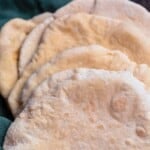
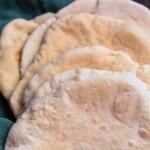
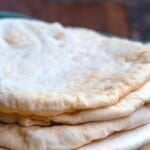
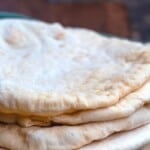
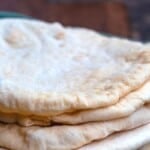
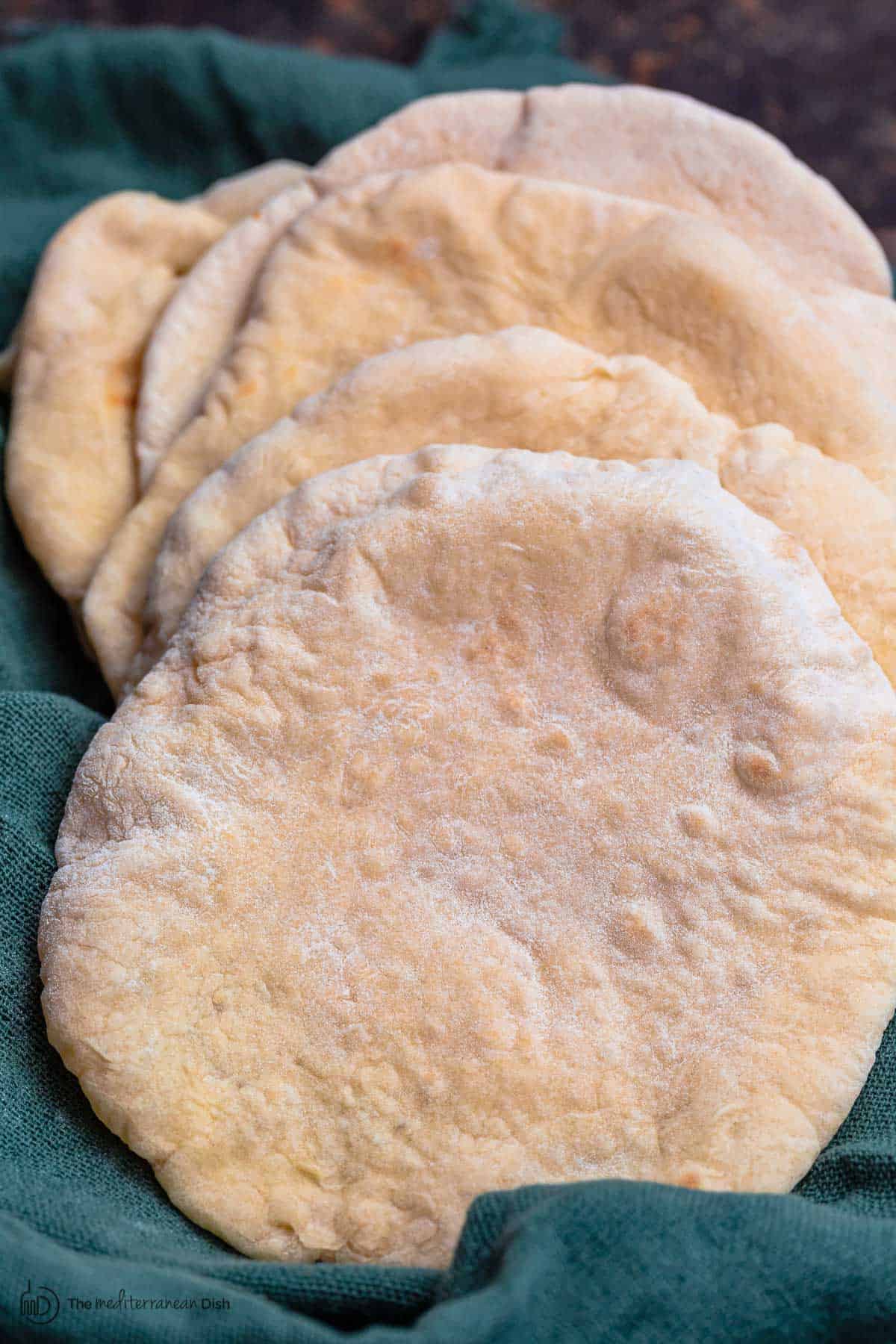
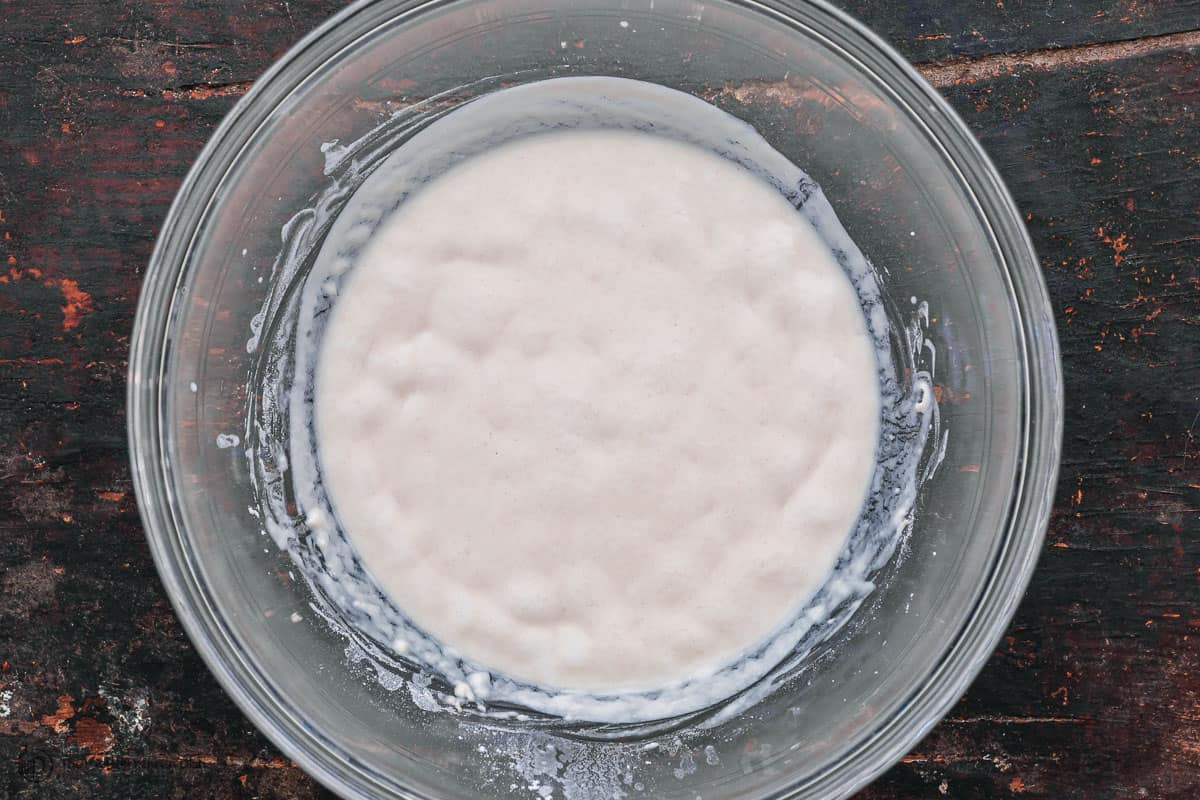
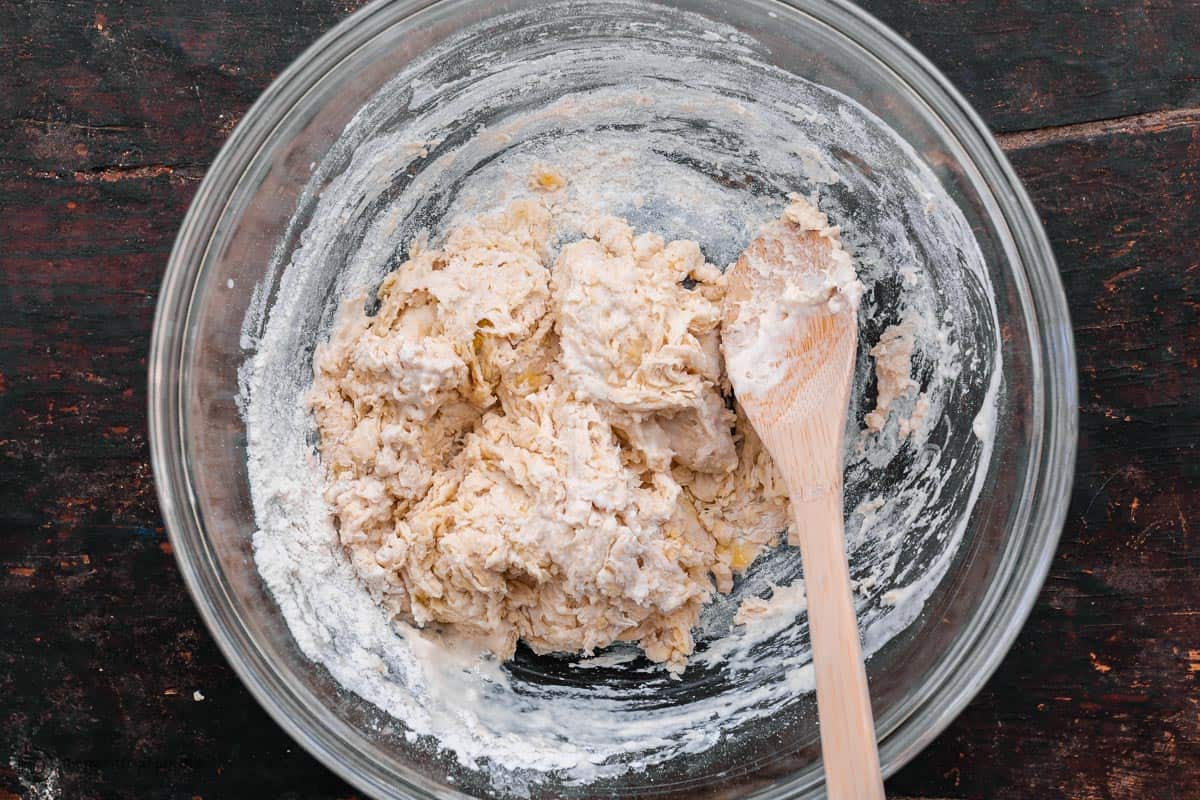
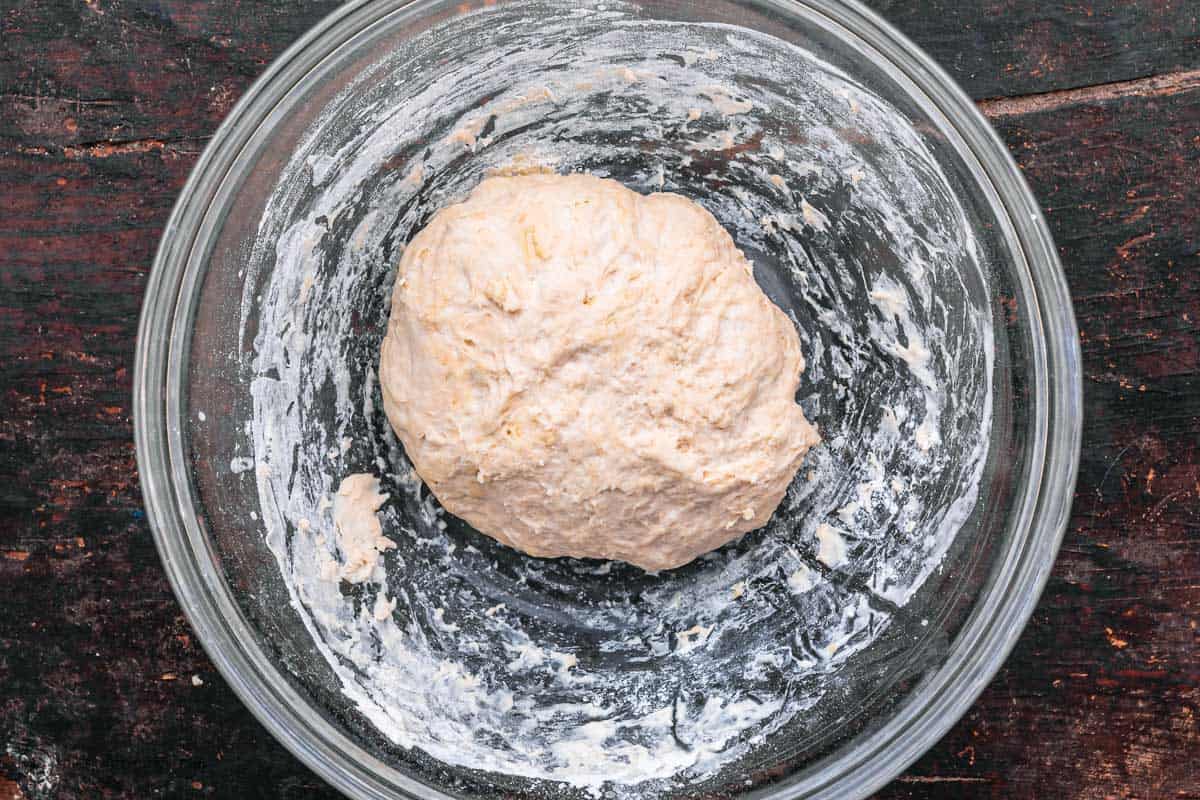
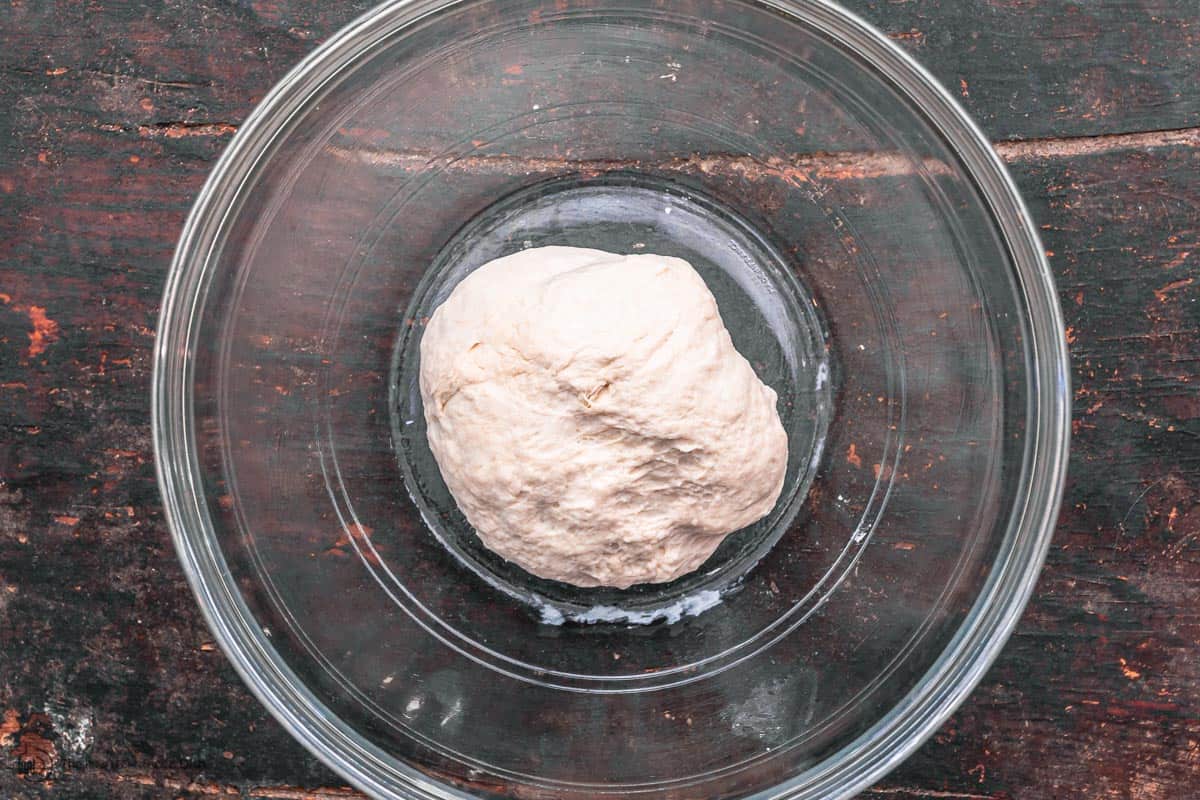
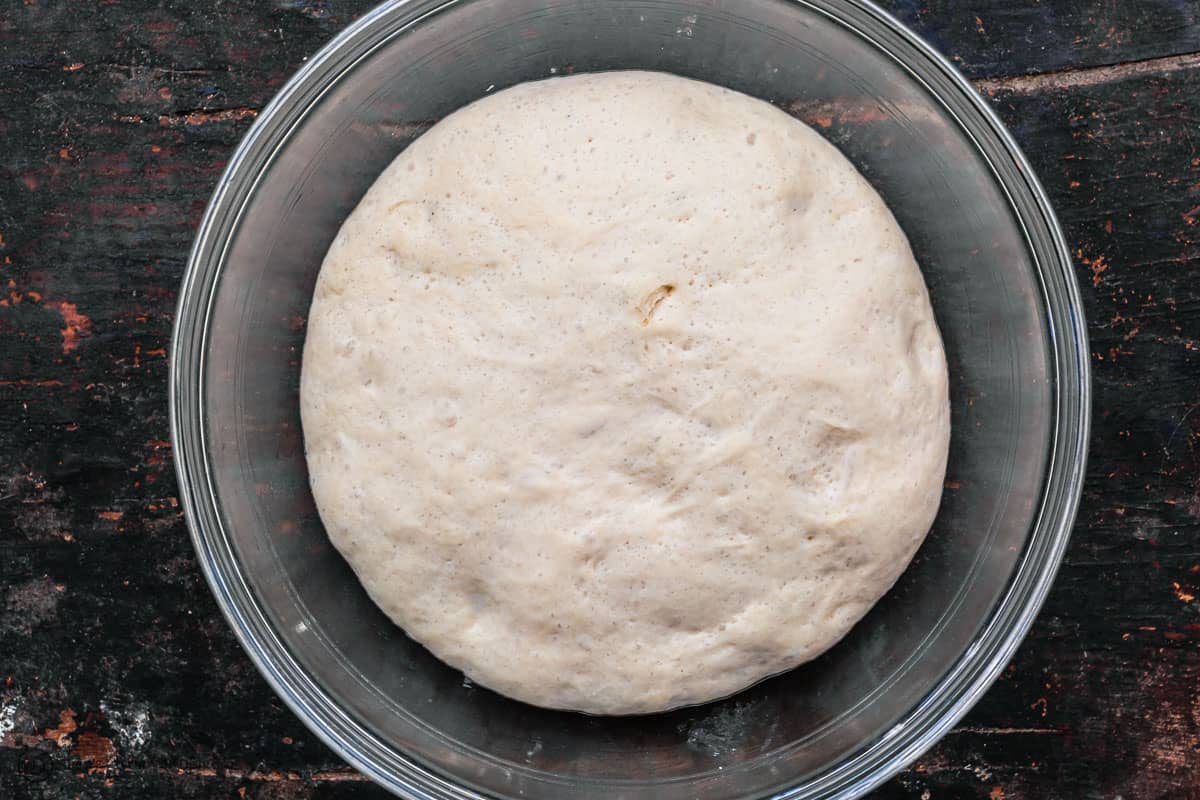
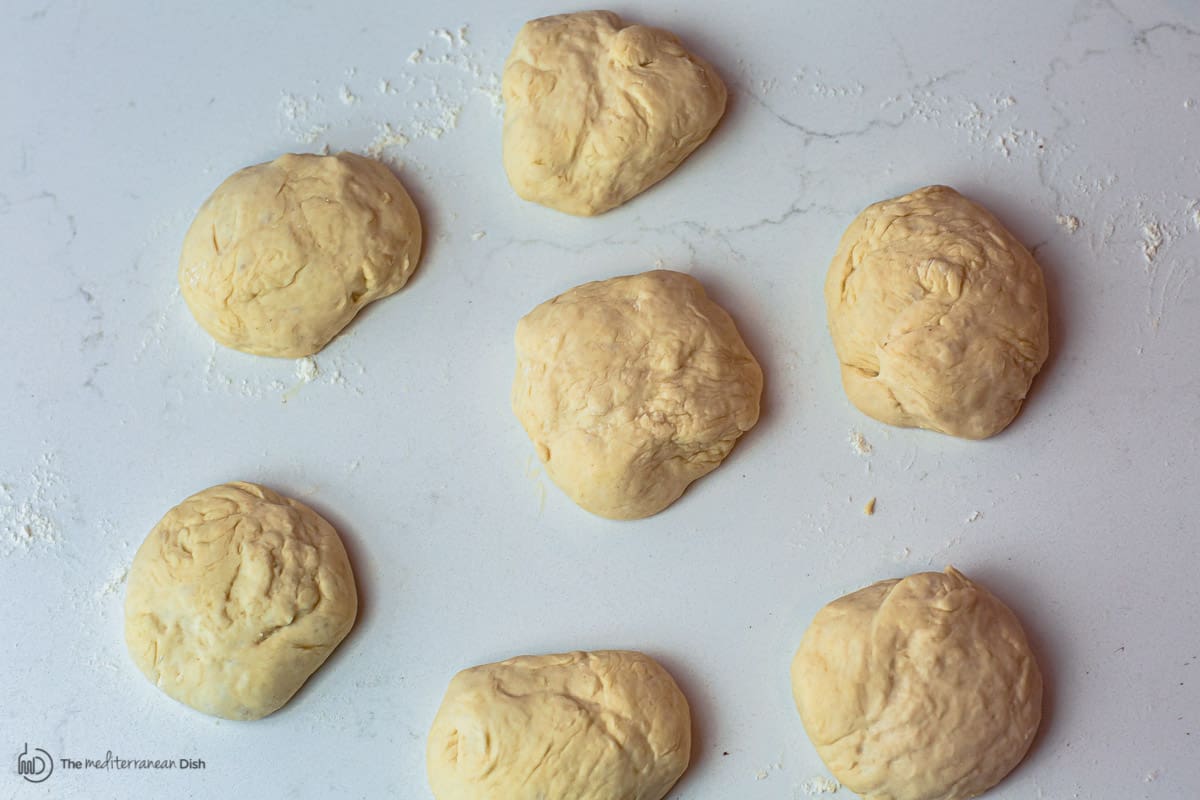
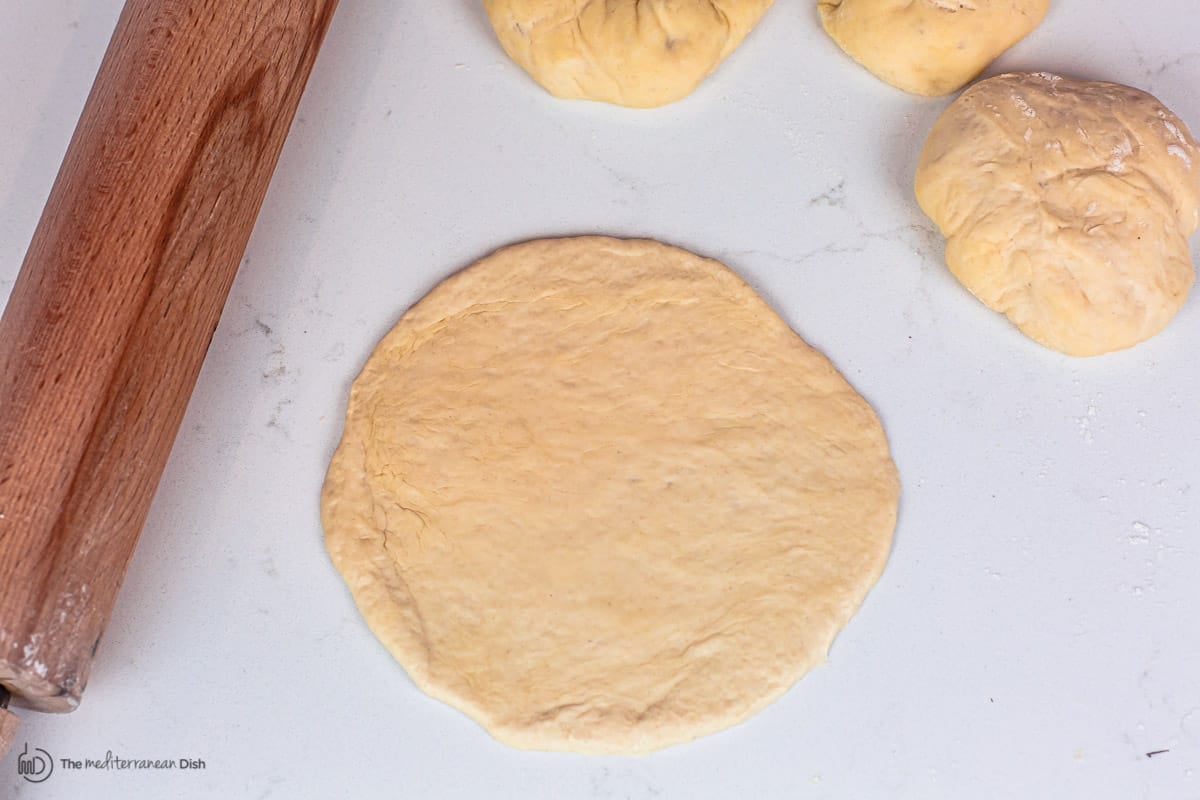
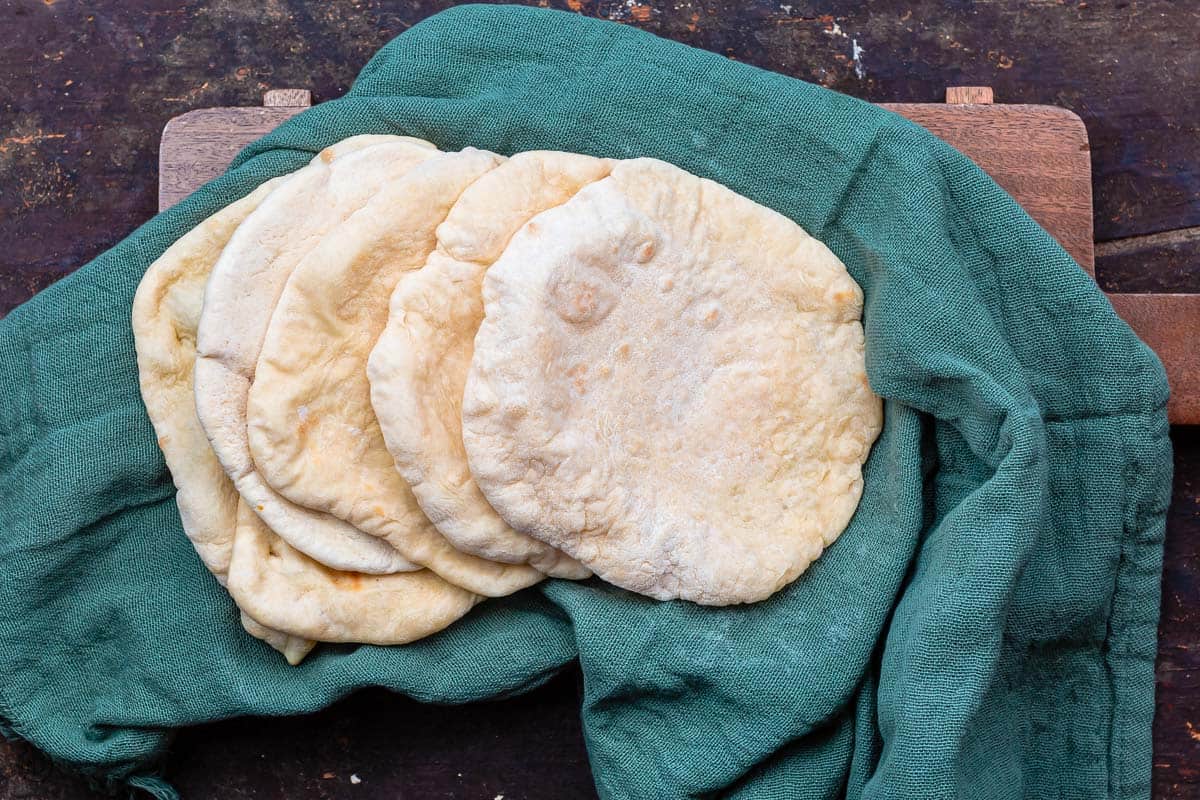
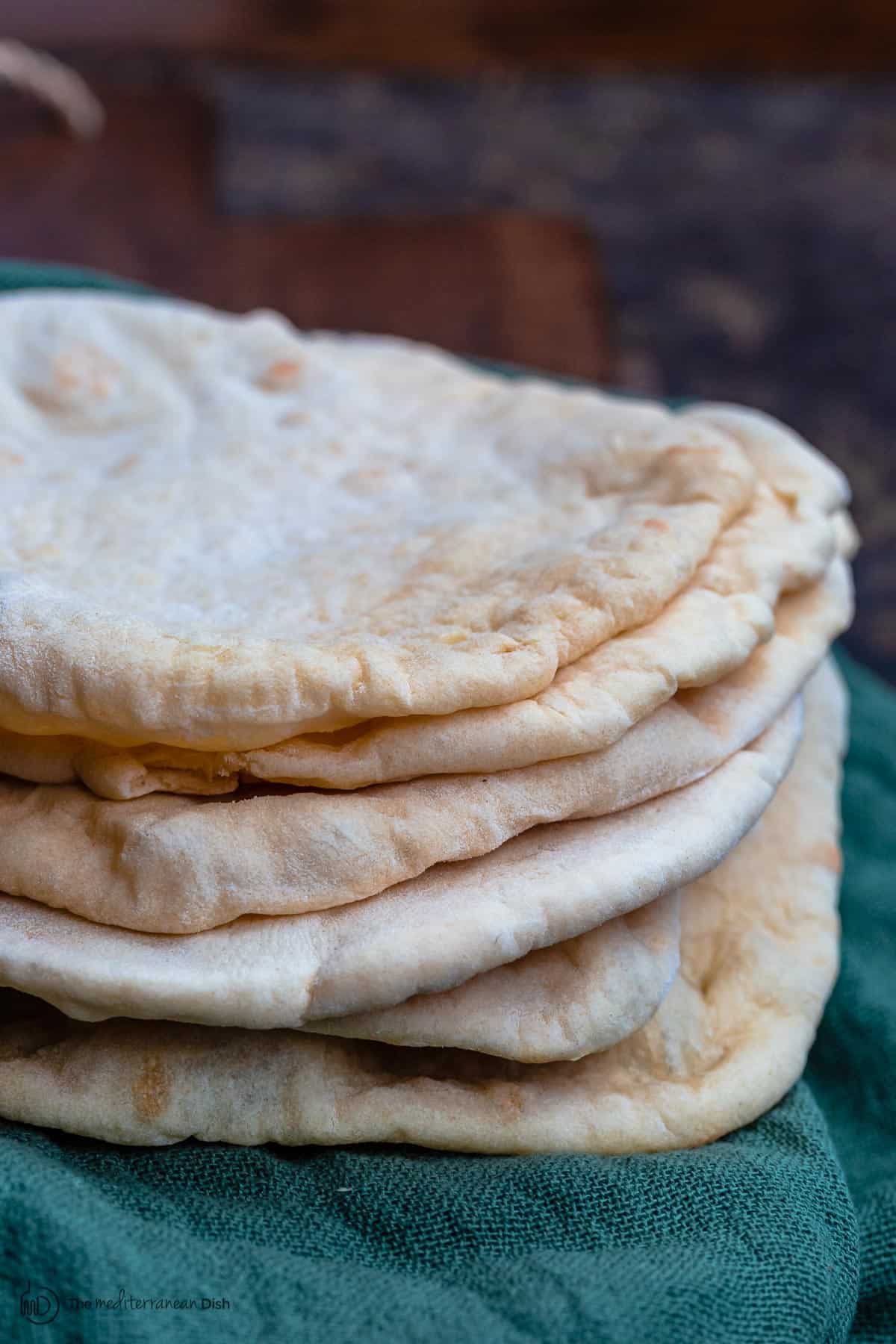
This sounds delicious! I may have missed it somewhere, how much yeast should be used?
Hi, Tiff! The recipe calls for 2 teaspoons of yeast.
do you think I could cook these on my stovetop griddle? Several at a time?
Hi, Anne. I highly recommend cast iron because it holds and distributes heat well, which you need especially for something like this. But you can try a different skillet, I’m just not sure how well the pitas will puff. If you don’t have a cast iron pan, it may be best to use a baking sheet and bake the pita. Not sure if you’ll be able to several at a time in either case… it depends on the size of your pans. I can only get one at a time on a skillet, and a few on a baking sheet.
This made the best pita I have ever eaten. I used 100% all purpose flour (because I was out of wheat) and baked them on a pizza stone. Thank you so much for this recipe!❤
Can this be made with whole wheat flour only ?
Hello! For this recipe, I really recommend doing 1 1/2 cup whole wheat flour and 1 1/2 white all purpose flour for best results, but using whole wheat flour should work okay if that’s what you prefer.
An absolutely fantastic recipe for the tastiest, easiest to make pita bread around. Thank you, Suzy!
Hi, in reading all of the comments, I wanted to make sure I understood that the 3 c flour divided is:
1/2 c for the sponge
2 c for the batter
1/2 dusting
totalling 3 cups? Is this correct?
That’s correct 🙂
I have a question. I’ve made this pita several times, and the third time was definitely the charm. Here’s my question: After I turn the pitas over, the side that “puffed” (the original top of the bread) is much thinner than the side that was on the baking stone. Do you know why that would happen, or do you have a solution? I can see that the pocket that is created has a much thinner top. Thank you and again, thank you for sharing.
Hi, Celie. I’ve had that happen before, as well. I can’t say I really understand why, so I don’t really have a great solution at the moment, unfortunately.
My dough is dry. I followed three recipe but having trouble at the kneading stage. I even left out the 1/2 cup flour and it’s very dry not kneading together well.
If your dough is a little dry, I’d try adding a bit more water next time.
My attempt following the recipe exactly was too also dry.
Just FYI 1 cup of liquid (water) is 240 grams
Do folks use 1 or 2 tsp of salt? I’m making these now and that’s a huge difference between the two
Hi, Louise! When it comes to salt, it really will vary for individual taste, so it is tricky. I tend to lean more towards on tsp myself.
Amazing, delicious and easy. Love making pitas now!
Yay! Thanks, Ragna!
Hi not sure this is the right place for the question. I would like to buy the pita bread. Can you recommend a brand? Maybe something I can order on line? Thanks love your recipes! Susan
Hi, Susan! To be honest, if I purchase pita, I get it fresh from a local bakery… so I would start there in your town. I really haven’t found any store brands that I love and could recommend.
Ty:)
When I scaled up the recipe (2X), it still stated that you use 1 cup of warm water. Should the water be increased? When I added the flour, it looked and felt more like a pie crust dough. I added water after the fact but it doesn’t look very well mixed. Still going to try and see if it rises. Keeping my fingers crossed.
Hi, Lisa. The scale up option is not always accurate because it is automated. If the one cup did not work for you, go ahead and try 2 next time.
Do you have a recipe for Greek flatbread – like the kind used for gyros? I’m looking for a good one with no pocket.
Hi, Angie. I don’t have a specific recipe for anything like that at the moment. This does work well for gyros, though.
Do you happen to have the weighted measurements (as opposed to volume) for this recipe? I prefer using my scale so I have less chance of screwing things up. haha. Thank you!!
We don’t at the moment for this one, unfortunately. We’re working on it, though!
OH YEAH!!!! I have tried several other pita recipes, all of which were only so-so. After deflating this dough and feeling how silky it was, I knew this recipe would be different. THIS IS A WINNER!!!!! I can’t even tell you how excited I was to watch them puff in the oven. And the taste — OUT OF THIS WORLD!!! (My husband can attest to everything I’ve written!) This is definitely MY pita recipe. And, on another note, I can tell by the softness and silkiness of the dough that this will make an awesome pizza. I’ll be trying that out this weekend.
Thank you for sharing your tradition and your wonderful recipe. I’m a fan!!!!
Thanks you so much Celie! I’m so glad the recipe was a hit for you guys!
Ok — so I said I would make this as a pizza, and here’s my story.
There’s a bakery near my house that makes a crazy good pizza dough — soft and silky (like your dough), and full of air bubbles. It makes a light, crispy pizza, which we like. Your dough is exactly the same as the bakery’s. One recipe made two small-ish pizzas. We like a full, 16″ pizza, so next time, I’ll make 1 1/2 times the recipe, and that will give me the right amount of dough for 2 16″ pies. One of your doughs is too big for one pizza, and not quite big enough for two pies.
The flavor of the crust is excellent (just like the pita bread), it’s light and crispy and just full of air bubbles. Even though the crust is thin and crispy, it’s strong enough to hold meatballs on top of the pizza.
I make pizza every week, and I’ve tried countless recipes, all of which claim to be “the best pizza dough”. Well, I just have to tell you (and your followers) that YOUR dough for pita bread is truly THE BEST pizza dough. I get very excited over a good yeast dough, and yours has made me a very happy girl.
I think you are the queen of the Mediterranean kitchen!! Thank you again for sharing. I’m eager to try some of your other recipes.
Wow! This is awesome to hear! Thanks for sharing, Celie!
Hi there! I made these last night to go with some hummus and dips from a local restaurant. I used garlic infused olive oil, and they were DELICIOUS, but I need a little more practice to get them to puff (I will try them in the oven next time). @Celie, I am very interested in using this dough for pizzas, and I was wondering if you could explain a bit more about your process. Do you cook the dough first, allowing it to puff up, and then put the toppings on and pop it back in the oven? Or do you cook it all at once with the toppings on? I am experimenting with this, and would love to hear your experience. Thanks so much!